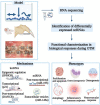Role of noncoding RNAs in orthodontic tooth movement: new insights into periodontium remodeling
- PMID: 36759852
- PMCID: PMC9912641
- DOI: 10.1186/s12967-023-03951-9
Role of noncoding RNAs in orthodontic tooth movement: new insights into periodontium remodeling
Abstract
Orthodontic tooth movement (OTM) is biologically based on the spatiotemporal remodeling process in periodontium, the mechanisms of which remain obscure. Noncoding RNAs (ncRNAs), especially microRNAs and long noncoding RNAs, play a pivotal role in maintaining periodontal homeostasis at the transcriptional, post-transcriptional, and epigenetic levels. Under force stimuli, mechanosensitive ncRNAs with altered expression levels transduce mechanical load to modulate intracellular genes. These ncRNAs regulate the biomechanical responses of periodontium in the catabolic, anabolic, and coupling phases throughout OTM. To achieve this, down or upregulated ncRNAs actively participate in cell proliferation, differentiation, autophagy, inflammatory, immune, and neurovascular responses. This review highlights the regulatory mechanism of fine-tuning ncRNAs in periodontium remodeling during OTM, laying the foundation for safe, precise, and personalized orthodontic treatment.
Keywords: Noncoding RNA; Orthodontic tooth movement; Orthodontic treatment; Periodontium remodeling.
© 2023. The Author(s).
Conflict of interest statement
The authors declare that they have no competing interests.
Figures






Similar articles
-
microRNA-21 Contributes to Orthodontic Tooth Movement.J Dent Res. 2016 Nov;95(12):1425-1433. doi: 10.1177/0022034516657043. Epub 2016 Jul 20. J Dent Res. 2016. PMID: 27422860
-
Biomechanical and biological responses of periodontium in orthodontic tooth movement: up-date in a new decade.Int J Oral Sci. 2021 Jun 28;13(1):20. doi: 10.1038/s41368-021-00125-5. Int J Oral Sci. 2021. PMID: 34183652 Free PMC article. Review.
-
In Vitro Compression Model for Orthodontic Tooth Movement Modulates Human Periodontal Ligament Fibroblast Proliferation, Apoptosis and Cell Cycle.Biomolecules. 2021 Jun 23;11(7):932. doi: 10.3390/biom11070932. Biomolecules. 2021. PMID: 34201602 Free PMC article.
-
Neural regulation of alveolar bone remodeling and periodontal ligament metabolism during orthodontic tooth movement in response to therapeutic loading.J World Fed Orthod. 2022 Oct;11(5):139-145. doi: 10.1016/j.ejwf.2022.08.003. Epub 2022 Sep 27. J World Fed Orthod. 2022. PMID: 36175332 Review.
-
Role of mechanosensitive ion channel Piezo1 in tension-side orthodontic alveolar bone remodeling in rats.Arch Oral Biol. 2023 Nov;155:105798. doi: 10.1016/j.archoralbio.2023.105798. Epub 2023 Aug 26. Arch Oral Biol. 2023. PMID: 37651768
Cited by
-
Mechanical force-activated CD109 on periodontal ligament stem cells governs osteogenesis and osteoclast to promote alveolar bone remodeling.Stem Cells Transl Med. 2024 Aug 16;13(8):812-825. doi: 10.1093/stcltm/szae035. Stem Cells Transl Med. 2024. PMID: 38885217 Free PMC article.
-
Circular RNA-Mediated Regulation of Oral Tissue-Derived Stem Cell Differentiation: Implications for Oral Medicine and Orthodontic Applications.Stem Cell Rev Rep. 2024 Apr;20(3):656-671. doi: 10.1007/s12015-024-10683-w. Epub 2024 Jan 27. Stem Cell Rev Rep. 2024. PMID: 38279054 Free PMC article. Review.
-
Stem Cells: Present Understanding and Prospects for Regenerative Dentistry.J Funct Biomater. 2024 Oct 15;15(10):308. doi: 10.3390/jfb15100308. J Funct Biomater. 2024. PMID: 39452606 Free PMC article. Review.
-
Levels of Inflammatory and Bone Metabolic Markers in the Gingival Crevicular Fluid of Individuals Undergoing Fixed Orthodontic Treatment in Comparison to Those Utilizing Invisalign.Medicina (Kaunas). 2023 Dec 1;59(12):2107. doi: 10.3390/medicina59122107. Medicina (Kaunas). 2023. PMID: 38138210 Free PMC article.
-
Characterization of a periodontal-inflammatory microRNA profile during multibracket orthodontic treatment in adolescents.Sci Rep. 2025 Jun 3;15(1):19488. doi: 10.1038/s41598-025-01794-6. Sci Rep. 2025. PMID: 40461544 Free PMC article.
References
-
- Huang H, Williams RC, Kyrkanides S. Accelerated orthodontic tooth movement: molecular mechanisms. Am J Orthod Dentofacial Orthop. 2014;146(5):620–32. - PubMed
-
- Antoun JS, Mei L, Gibbs K, Farella M. Effect of orthodontic treatment on the periodontal tissues. Periodontol 2000. 2017;74(1):140–57. - PubMed
-
- Cattaneo PM, Dalstra M, Melsen B. Strains in periodontal ligament and alveolar bone associated with orthodontic tooth movement analyzed by finite element. Orthod Craniofac Res. 2009;12(2):120–8. - PubMed
-
- Viecilli RF, Katona TR, Chen J, Hartsfield JK, Jr, Roberts WE. Three-dimensional mechanical environment of orthodontic tooth movement and root resorption. Am J Orthod Dentofacial Orthop. 2008;133(6):791e11–26. - PubMed
Publication types
MeSH terms
Substances
LinkOut - more resources
Full Text Sources

